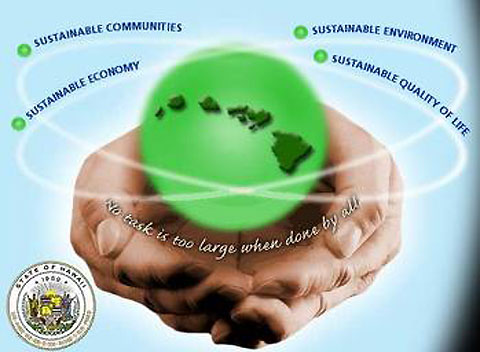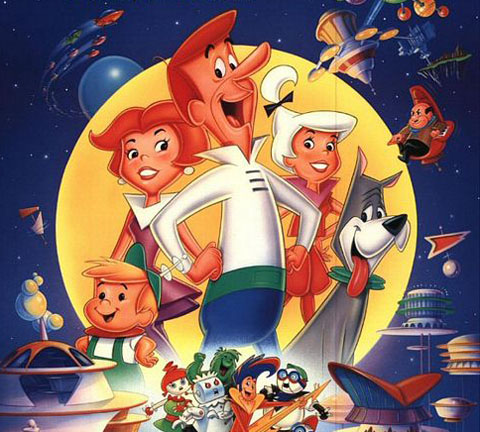by Juan Wilson on 2 March 2007
I volunteered to host a community meeting for the 2050 Sustainability Task Force. I have received a package from Diane Zachery, of Kauai Planning & Action Alliance, that included three PDF files that are the documentation required to host such a meeting.
Anyway, I will have to un-volunteer for such a role . After reviewing this material I have concluded that this questionaire is the heart of the Communmity Meeting and is just about useless. That is disapointing to me. There are a couple of opportunities for individuals to submit their own concerns, and there are a couple of questions on the importance of Hawaiian
values and historic systems (like ahupuaa), but it is thin gruel amongst the silly stuff like how important is it that - "Decision making provides for current needs and the needs of future generations." Duh? I have come to the conclusion that community meetings organized like this one are a waste of time.
There is an online method for answering a three page multiple choice questionaire that is the heart of the meeting. It is available on your desk or at the library at:
http://www.hawaii2050.org/survey.php
For more on the documents needed to host a community meeting read on. You can download them yourself and act on them if you like.
They PDF documnets are:
Community Meeting Flyer
An invitation to come to a community meeting to discuss sustainability.
This flyer requires the host providing RSVP info and determining and filling in a date, time, and place for a meeting.
Host Instruction Sheet
This two page document are instructions for the host on how to conduct the community meeting.
Community Meeting Toolkit
This is a seventeen page document that for the use of the meeting participant.
The Toolkit repeats meeting instructions (4 pages). It also includes a cover sheet with space for a dozen participant names that is signup sheet (a contact building effort by Hwaii 2050). It iincludes background information on the 2050 Task Force (4 pages) and also a fictional refelction back from 2050 on what "might have been" (2 pages) and ends with a multiple choice questionaire (3 pages) that asks the
participant to grade the importance of a list of principles like - "Development decisions are predictable, fair and cost-effective." The questionaire never asks if development is a good idea.
Here's the reflection from the point of view of an individual Hawaiian in 2050.
Futures Scenario
Reflecting Back from the Year 2050
(This is a fictional piece and is only intended to encourage discussion and thought.) Sometimes I wonder what would have happened if the Hawai‘i 2050 Sustainability Plan had been adopted back in 2008. I was just a teenager back then but I remember some of the community meetings and discussions that occurred. My mom went to many of the meetings and she insisted I join her. She was like that –a
real community advocate. She really cared a lot about the future and thought I should be exposed to these ideas as well. I guess the 2050 Sustainability Plan failed because not enough people took planning for the future seriously. There were just too many current issues that needed to be addressed. And even then, the term “sustainability” was being criticized as too abstract and over-used. Not enough people embraced the notion of making choices
today for future generations.
The State of Hawai‘i is really not a state any more. Today we have two separate governments, neither of which is representative. We lost democracy nearly 20 years ago. Voter participation continued to decline and eventually the few voters agreed that a representative government no longer made sense. So instead, the few remaining voters approved the creation of two governing authorities – self-perpetuating bodies that appoint new members as needed.
The two governments have authority over our now divided state.
Since we couldn’t figure out how to balance economic, social and environmental interests, we just decided to divide the state of
Hawai‘i into two separate parts. Some people live in the half that is very focused on self-sufficiency – it has been re-named Self-Hawai‘i. The people who live in Self-Hawai‘i grow their own food and
most of the materials they consume. Unfortunately, we didn’t plan well for water use, so water is very limited and expensive.
Consequently, these families must work very hard to feed themselves. Family size has grown, like in the days before the Industrial evolution, as children are needed to work on family farms. As a result, children have limited time for school or social activities.
Also, because we weren’t able to develop alternative energy sources and oil has become scarce and extremely expensive, families who live in Self-Hawai‘i are very isolated. There is very limited public transportation and the only affordable travel between islands is by canoe.
The other part of the former state of Hawai‘i, which was renamed Grow-Hawai‘i, was heavily developed during the early part of the 21st Century. The tourism industry declined as we continued to sacrifice the natural environment for more and more development. We brought in alternative, diverse industries but paid little attention to how prepared our children would be to work in these new industries.
Consequently, we have had a very difficult time remaining competitive in the global economy; and we struggle to produce comparable profits and pay good wages.
In Grow-Hawai‘i, traffic continued to be a problem, and with the rising cost of oil, fewer families were willing to deal with commuting to work. As a result, working from home has become the norm. Nearly 80% of workers in Grow-Hawai‘i now work from their homes. With uncontrolled development, recreation in the natural environment – the ocean or the mountains –is nearly impossible. Consumerism has continued to accelerate. Many only find
joy in having more. This rising materialism, coupled with the high cost of housing, health care and education, means that Grow-Hawai‘i families must work two and three jobs just to afford their lifestyle. Isolation grows as families spend more and more time internet shopping and working remotely from home.
I wonder if we would have these challenges today, in 2050, if we had paid more attention to the future when we still had a chance, back in 2007.
|
For more information about the 2050 Sustainability Task Force Community Meetings get in touch with Kauai Planning & Action Alliance (KPAA). It is assisting by organizing efforts on Kauai. If you would be interested in hosting a small gathering of friends, family or colleagues to discuss ideas about how to ensure a sustainable Hawaii for generations to come, please contact:
Diane Zachary at KPAA
phone: (808) 632-2005
email: dzachary@kauainetwork.org
Hosts will receive a meeting toolkit, with background information, questions for discussion and individual response forms. The meetings will take only 30 to 60 minutes. This is a great way to be sure your voice is heard in this statewide initiative.
If you are not able to attend one of these discussions but would like to share your ideas, you have the opportunity to participate via an online survey at www.hawaii2050.org/survey.php.
Questions about KPAA? Comments? Please visit or contact:
Kaua`i Planning & Action Alliance, Inc.
2959 Umi Street, Suite 201, Lihu'e, HI 96766
phone: (808) 632-2005
fax: (808) 632-2018
email: kpaa@kauainetwork.org
website: www.kauainetwork.org
check out:
www.hawaii2050.org
www.futures.hawaii.edu
www.metafuture.org
www.kanuhawaii.org
Island Breath: Community Meeting Hosts
Island Breath: Our 2050 Vision Statement
Island Breath: Hawaii 2050 Kauai Meeting
Island Breath: Hawaii 2050 Background
Island Breath: Hawaii 2050 Conference
Island Breath: No growth feasible
Island Breath: Cuba shows how |

